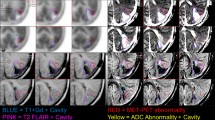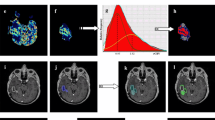Abstract
Delayed structural cerebral sequelae has been reported following cranial radiation therapy (CRT) to children with primary brain tumors, but little is known about potential functional changes. Twenty-four patients were included, diagnosed and treated at a median age of 11 years, and examined after a median recurrence free survival of 16 years by MRI and Positron Emission Tomography using the glucose analog 2-18F-fluoro-2-deoxy-D-glucose (18FDG). Three patients were not analyzed further due to diffuse cerebral atrophy, which might be related to previous hydrocephalus. Twenty-one patients were evaluable and regional cerebral metabolic rate for glucose (rCMRglc) was estimated in nontumoral brain regions in 12 patients treated with surgery alone and 9 patients treated with both surgery and CRT. Furthermore 10 normal controls matched for age at examination were included. Patients treated with both surgery and CRT had a general decreased rCMRglc compared to normal controls and patients treated with surgery alone, significantly (p < 0.05) in 5 of 11 regions of interest. No difference was found in rCMRglc between normal controls and patients treated with surgery alone. We conclude that there is a general reduction in rCMRglc in long-term recurrence free survivors of childhood primary brain tumors treated with CRT in high doses (44–56 Gy).
Similar content being viewed by others
References
Jenkin D: Long-term survival of children with brain tumors. Oncology Huntingt 10: 715–719, 1996
Duffner PK, Cohen ME: The long-term effects of central nervous system therapy on children with brain tumors. Neurol Clin 9: 479–495, 1991
Mulhern RK, Hancock J, Fairclough D, Kun L: Neuropsychological status of children treated for brain tumors: a critical review and integrative analysis. Med Pediatr Oncol 20: 181–191, 1992
Constine LS, Woolf PD, Cann D, Mick G, McCormick K, Raubertas RF, Rubin P: Hypothalamic-pituitary dysfunction after radiation for brain. N Engl J Med 328: 87–94, 1993
Taylor JM, Mendenhall WM, Lavey RS: Dose, time, and fraction size issues for late effects in head and neck cancers. Int J Radiat Oncol Biol Phys 22: 3–11, 1992
Silber JH, Radcliffe J, Peckham V, Perilongo G, Kishnani P, Fridman M, Goldwein JW, Meadows AT: Whole-brain irradiation and decline in intelligence: the influence of dose and age on IQ score. J Clin Oncol 10: 1390–1396, 1992
Burger PC, Boyko OB: The pathology of central nervous system radiation injury. In: Gutin PH, Leibel SA, Sheline GE (eds) Radiation Injury to the Nervous System. Raven Press, New York, 1991, pp 191–208
Valk PE, Dillon WP: Radiation injury of the brain. Am J Neuroradiol 12: 45–62, 1991
Constine LS, Konski A, Ekholm S, McDonald S, Rubin P: Adverse effects of brain irradiation correlated with MR and CTimaging. Int J Radiat Oncol Biol Phys 15: 319–330, 1988
Curran WJ, Hecht Leavitt C, Schut L, Zimmerman RA, Nelson DF: Magnetic resonance imaging of cranial radiation lesions. Int J Radiat Oncol Biol Phys 13: 1093–1098, 1987
Bleyer WA, Griffin TW: White matter necrosis, mineralizing microangiopathy, and intellectual abilities in survivors of childhood leukemia. In: Gilbert HA, Kagan AR (eds) Radiation Damage to the Nervous System:ADelayed Therapeutic Hazard. Raven Press, New York, 1980, pp 155–174
Packer RJ, Zimmerman RA, Bilaniuk LT: Magnetic resonance imaging in the evaluation of treatment-related central nervous system damage. Cancer 58: 635–640, 1986
Kramer JH, Norman D, Brant Zawadzki M, Ablin A, Moore IM: Absence of white matter changes on magnetic resonance imaging in children treated withCNSprophylaxis therapy for leukemia. Cancer 61: 928–930, 1988
Kaushal V, Bidmead M, Hill L, Brada M: Radiotherapy of brain tumours: reduced irradiation of normal brain. Clin Oncol R Coll Radiol 2: 338–342, 1990
Kleihues P, Burger PC, Scheithauer BW: Histologic Typing ofTumours of the Central Nervous System. Springer-Verlag, Berlin, 1993
Scheltens P, Barkhof F, Leys D, Pruvo JP, Nauta JJP, Vermers P, Steinling M, Valk J: A semiquantitative rating scale for the assessment of signal hyperintensities on magnetic resonance imaging. J Neurol Sci 114: 7–12, 1993
Patlak CS, Blasberg RG: Graphical evaluation of bloodto-brain transfer constants from multiple-time uptake data. Generalizations. J Cereb Blood Flow Metab 5: 584–590, 1985
Gjedde A, Wienhard K, Heiss WD, Kloster G, Diemer NH, Herholz K, Pawlik G: Comparative regional analysis of 2-fluorodeoxyglucose and methylglucose uptake in brain of four stroke patients. With special reference to the regional estimation of the lumped constant. J Cereb Blood Flow Metab 5: 163–178, 1985
Lucignani G, Schmidt KC, Moresco RM, Striano G, Colombo F, Sokoloff L, Fazio F: Measurement of regional cerebral glucose utilization with fluorine-18-FDG and PET in heterogeneous tissues: theoretical considerations and practical procedure. J Nucl Med 34: 360–369, 1993
Hasselbalch SG, Madsen PL, Knudsen GM, Holm S, Paulson OB: Calculation of the FDG lumped constant by simultaneous measurements of global glucose and FDG metabolism in humans. J Cereb Blood Flow Metab 18: 154–160, 1998
Greitz T, Bohm C, Holte S, Eriksson L: A computerized brain atlas: construction, anatomical content, and some applications. J Comput Assist Tomogr 15: 26–38, 1991
Altman DG: Practical Statistics for Medical Research. Chapman & Hall, London, 1991
Tanaka A, Ueno H, Yamashita Y, Caveness WF: Regional cerebral blood flow in delayed brain swelling following x-irradiation of the right occipital lobe in the monkey. Brain Res 96: 233–246, 1975
Keyeux A, Brucher JM, Ochrymowicz Bemelmans D, Charlier AA: Late effects of X irradiation on regulation of cerebral blood flow after whole-brain exposure in rats. Radiat Res 147: 621–630, 1997
Ito M, Patronas NJ, Di Chiro G, Mansi L, Kennedy C: Effect of moderate level x-radiation to brain on cerebral glucose utilization. J Comput Assist Tomogr 10: 584–588, 1986
d'Avella D, Cicciarello R, Albiero F, Mesiti M, Gagliardi ME, Russi E, d'Aquino A, Princi P, d'Aquino S: Effect of whole brain radiation on local cerebral glucose utilization in the rat. Neurosurgery 28: 491–495, 1991
Mineura K, Suda Y, Yasuda T, Kowada M, Ogawa T, Shishido F, Uemura K: Early and late stage positron emission tomography (PET) studies on the haemocirculation and metabolism of seemingly normal brain tissue in patients with gliomas following radiochemotherapy. Acta Neurochir Wien 93: 110–115, 1988
Phillips PC, Moeller JR, Sidtis JJ, Dhawan V, Steinherz PG, Strother SC, Ginos JZ, Rottenberg DA: Abnormal cerebral glucose metabolism in long-term survivors of childhood acute lymphocytic leukemia. Ann Neurol 29: 263–271, 1991
Beaney RP, Gibbs JS, Brooks DJ, McKenzie CG, Joplin GF, Jones T: Absence of irradiation induced ischaemic temporal lobe damage in patients with pituitary tumours. J Neuro-Oncol 5: 129–137, 1987
Baron JC, Levasseur M, Mazoyer B, Legault Demare F, Mauguiere F, Pappata S, Jedynak P, Derome P, Cambier J, Tran Dinh S, et al: Thalamocortical diaschisis: positron emission tomography in humans. J Neurol Neurosurg Psychiatry 55: 935–942, 1992
Fulham MJ, Brooks RA, Hallett M, Di Chiro G: Cerebellar diaschisis revisited: pontine hypometabolism and dentate sparing. Neurology 42: 2267–2273, 1992
Patronas NJ, Di Chiro G, Smith BH, De La Paz R, Brooks RA, Milam HL, Kornblith PL, Bairamian D, Mansi L: Depressed cerebellar glucose metabolism in supratentorial tumors. Brain Res 291: 93–101, 1984
Fulham MJ, Brunetti A, Aloj L, Raman R, Dwyer AJ, Di Chiro G: Decreased cerebral glucose metabolism in patients with brain tumors: an effect of corticosteroids. J Neurosurg 83: 657–664, 1995
Roelcke U, Blasberg RG, von Ammon K, Hofer S, Vontobel P, Maguire RP, Radu EW, Herrmann R, Leenders KL: Dexamethasone treatment and plasma glucose levels: relevance for fluorine-18-fluorodeoxyglucose uptake measurements in gliomas. J Nucl Med 39: 879–884, 1998
Author information
Authors and Affiliations
Rights and permissions
About this article
Cite this article
Andersen, P.B., Krabbe, K., Leffers, A.M. et al. Cerebral glucose metabolism in long-term survivors of childhood primary brain tumors treated with surgery and radiotherapy. J Neurooncol 62, 305–313 (2003). https://doi.org/10.1023/A:1023371424483
Issue Date:
DOI: https://doi.org/10.1023/A:1023371424483




